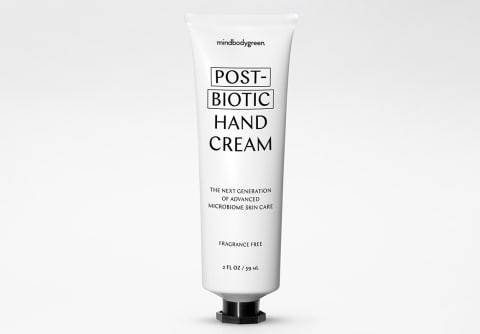How To Deal With Thin, Crepey Skin On The Hands According To An Editor
Areas of thin skin on the face and body tend to be the areas that show the first visible signs of aging skin. Like crepey appearance on the hands.


mbg Beauty Director
mbg Beauty Director
Alexandra Engler is the beauty director at mindbodygreen and host of the beauty podcast Clean Beauty School. Previously, she's held beauty roles at Harper's Bazaar, Marie Claire, SELF, and Cosmopolitan; her byline has appeared in Esquire, Sports Illustrated, and Allure.com.
Image by Sveta SH / Stocksy July 10, 2024 We carefully vet all products and services featured on mindbodygreen using our Our selections are never influenced by the commissions earned from our links. The skin’s dermal thickness varies across the body. Some areas are thick and robust—like on the shoulders and trunk—so the skin is more durable. In others, the dermal layer is thin and delicate—like the eyes, lips, and even the back of the hands. 
The connection between dermal thickness & crepey skin on the hands
Perhaps not so coincidentally, these areas of thin skin on the face and body tend to be the areas that show the first visible signs of aging skin. This is because dermal thickness is incredibly important for skin health and appearance. The skin is made up of three layers1, the middle of which is the dermis.
This layer contains all of your skin's connective fibers, structural proteins, and other extracellular components, and is incredibly important for keeping skin structure firm, smooth, and vibrant.
Much of what we do in skin care and aesthetics is to support this layer—such as encouraging collagen and elastin production and protecting the skin from oxidative damage.
When this layer thins or atrophies, the skin will appear crepey, fragile, prone to wrinkles, and even bruises easily. In fact, “crepey skin” is simply a word we use to describe this exact phenomenon of the dermal layer thinning: "Skin 'crepiness' is commonly used to describe aging skin that appears thinner, has lost elasticity, and is more fragile, often with wrinkles," board-certified dermatologist, dermatologic surgeon, and founder of Spectrum Skin and Laser Jeremy Brauer, M.D., previously told us about crepey skin.
3 things that trigger dermal thinning on the hands:
The dermal layer is made up of collagen and elastin. When these decline, so does the dermal density.
If you’re curious about what triggers this loss and thinning to begin with, here are the top culprits:
How to support the skin on the hands
Caring for the skin on the hands is not much different than caring for skin on the face—just with a few tweaks given the unique needs of the hands.
The first step is to make sure you’re protecting the skin with sunscreen during sun exposure. A few application tips to make sure you remember:
Then be sure to support skin through barrier-strengthening and collagen-boosting routines.
When possible, switch to gentle, sulfate-free hand washes. Sulfates can strip the skin of its natural lipids, leading to a weakened barrier and increased inflammation. In the long run, this will thin out the dermal layer.
Look for non-irritating surfactants instead, such as: Sodium Lauroyl Methyl Isethionate, Sodium Cocoyl Isethionate, or Cocamidopropyl Betaine. Ideally, the hand wash will also have hydrating, soothing buffer ingredients like aloe, oat oil, glycerin, coconut oil, and so on.
Throughout the day, be sure to apply a hand cream regularly to support hydration, soothe irritation, and feed the skin antioxidants. A good hand cream can not only protect the dermal layer, but it can provide plumping hydration to ease the appearance of fine lines and crepey skin in the interim.
Look for options that have a robust formula, including: barrier strengthening emollients (oat oil, ceramides, moringa seed oil, etc.), moisture-trapping occlusives (shea butter, avocado oil), humectants (hyaluronic acid, aloe vera, glycerin), and antioxidants (coenzyme Q10, fruit extracts, vitamin E, etc.).
Editor tip:
Be sure to apply a hand cream within 2 minutes of washing your hands, ideally when the skin is still damp. This helps keep moisture trapped in the skin, and reduces the chances of transepidermal water loss.
At night, you may want to incorporate something more targeted to boost collagen, such as retinol, vitamin C, or glycolic acid. These ingredients have all been shown to increase collagen in the skin when used regularly.
However, these ingredients can be challenging to tolerate and shouldn’t be applied multiple times a day (like you might with a normal hand cream), so we encourage using them in the evening as a treatment alongside your daily hand cream and sunscreen use.
The takeaway
Thinning skin on the hands—often simply called “crepey skin”—is a common issue for many, especially with age. It’s caused by dermal thinning from collagen and elastin loss, which are triggered by UV damage, topical irritation, and age-related decline.

 Aliver
Aliver 





























